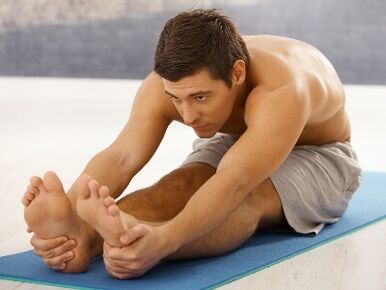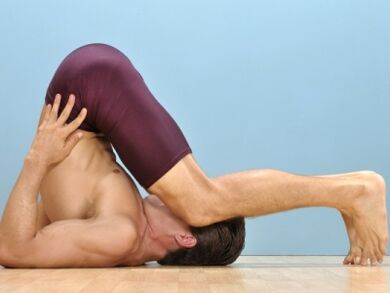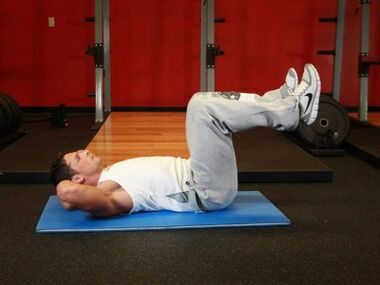
Prostatitis and benign prostatic hyperplasia are quite common diseases in elderly men.
The main symptom of prostate adenoma is pressure on the urethra to cause difficulty in urination.
For these diseases, under the framework of comprehensive treatment, combined with medicines and folk remedies, such as the use of dead bees to treat prostate adenoma, and surgical methods, as well as to prevent congestion and inflammation, it is recommended to carry out treatment exercises.
Special exercises for prostatitis and prostate adenoma should be carried out for a long enough time. Their purpose is to strengthen the muscles of the pelvis, perineum, and lower limbs, and to strengthen the body overall.
Also, show men the recommended exercises for prostatitis and prostate adenoma after prostate surgery to prevent complications. In this case, they should proceed in a gentle way, taking into account the health of the patient.
Physiotherapy of prostate adenoma: the main complex of physical exercise

Physical therapy and massage of prostate adenoma can improve the blood circulation of the pelvic organs.
This can prevent the development of pathological processes and reduce the growth rate of benign tumors.
The exercise of prostate adenoma includes static and dynamic exercise.
General strengthening exercises, such as walking, running, biking, etc. , are all called dynamic exercises. It is also worth doing exercises such as squatting, walking on the hips, rolling a ball, raising your legs and raising your pelvis while lying down.
Static exercise involves standing positions where certain muscle groups are tense for a long time.
Note that it is useful
Strengthening the back and abdominal muscles is essential. To do this, you can exercise in the supine, side, abdominal, twisting, and push-ups. An effective exercise is to ride a bicycle in the supine position, which complicates the exercise-pelvic elevation.
Various lifting and tilting, pelvic rotation movements are useful. There are special exercises for the perineal muscles.
The most famous and effective exercise for prostate adenoma is the Kegel complex, designed by gynecologists for women and modified for men. Its main exercises are standing and lying down, including training the muscles of the anus and perineum to prevent congestion of the perineum and small pelvis.
The complex should be performed in the morning, after sanitation procedures, and at night. It is recommended to exercise before going to bed for prostate adenoma 2-3 hours before going to bed.
notes
The exercise of prostate adenoma should take into account the patient’s physical and mental health, and should not be overworked and forced. The complexity of exercise must take into account the age of the patient and obtain the consent of the attending physician.
A set of exercises selected correctly after prostate surgery can provide important help during postoperative recovery. Exercise should be regular.
This set of exercises itself does not require much time, but regular use of it has a good effect on the body's general condition and the blood circulation of the pelvic organs, reducing the severity of congestion and edema.
In addition, strengthening the muscles of the abdomen and perineum has a positive effect on the urination process, and it will be an excellent way to prevent prostate adenoma in the future.
important
You should also pay attention to moderate exercises. It should bring pleasure and a slight sense of fatigue, but it should not be accompanied by painful feelings or exertion.
Therapeutic gymnastics for prostate adenoma

The recommended prostate adenoma gymnastics is not only suitable for benign prostatic hyperplasia, but also for those who have undergone surgery for prostate cancer due to chronic prostatitis.
Physiotherapy combined with medication can help reduce edema and congestion of the small pelvis, thereby reducing urethral obstruction and improving urine output. The treatment of prostate adenoma, gymnastics or exercise therapy is carried out in groups under the supervision of specialists, usually in medical institutions, including three stages.
In the first stage, perform general physical activities, including aerobic exercise, running, jumping and warming up.
In the second stage, special exercises are performed to strengthen the back muscles, abdominal muscles, and muscles in the perineal area, which help to empty the bladder. Various exercises were also performed to reduce the congestion of the pelvic organs.
The third stage is to stretch and relax the weight-bearing muscles during exercise.
notes
In order to obtain a stable effect, this practice process should be carried out regularly and takes a long time. The techniques of physical therapy exercises must be included in the complex of treatment measures, including medication, physical therapy, and surgery (if necessary).
Prostatic glandular tissue hyperplasia is an age-related disease, and its course depends to a large extent on the health and safety of the body.
Compliance with a healthy lifestyle, regular exercise, proper nutrition and adherence to diet, and avoiding bad habits have a great impact on the quality of life, and have a positive impact on the occurrence and course of the disease.
Maintaining the habit of physical activity and available exercise will allow you to maintain the function of your organs and systems for a long time even in old age.

























